Highly selective sigma receptor ligands and radioligands as probes in nociceptive processing and the pathphysiological study of memory deficits and cognitive disorders
a sigma receptor and radioligand technology, applied in the field of high-selective sigma receptor ligands and radioligands as probes in nociceptive processing and the pathphysiological study of memory deficits and cognitive disorders, can solve the problems of drug abuse, uncloned protein corresponding to -2 site, and limited pharmacological characterization of -2 subtypes, etc., to achieve better approaches to diagnose and treat pain
- Summary
- Abstract
- Description
- Claims
- Application Information
AI Technical Summary
Benefits of technology
Problems solved by technology
Method used
Image
Examples
Embodiment Construction
[0082]The generic structures of Formulae I, II, III, IV and V encompass a diverse range of heterocycles. Embodiments within this genus, for example, include 2(3H)-benzoxazolone (Y═O, Z═O) and 2(3H)-benzothiazolone (Y═S, Z═O) compounds and the sigma receptor affinity shown by these heterocycles. The 2(3H)-benzoxazolone (BOA) and its bioisosteric surrogate 2(3H)-benzothiazolone (BTA) heterocycle is a bicyclic ring system which promotes high versatility in organic synthesis involving N-substitution (either N-alkylation or N-acylation) and aromatic ring electrophilic substitution reactions.
[0083]
Chemical Structures of BOA and BTA
[0084]The present invention relates to compounds having the general formula I
[0085]
wherein R1 can be a radical of an optionally substituted C-4 to C-7 N-containing heterocycle or a radical of an optionally substituted cyclic or acyclic tertiary amine, or isoindoline-1,3-dione R2,3,4,5,6 can each independently be any one or combinations of the following moieties,...
PUM
 Login to View More
Login to View More Abstract
Description
Claims
Application Information
 Login to View More
Login to View More - R&D
- Intellectual Property
- Life Sciences
- Materials
- Tech Scout
- Unparalleled Data Quality
- Higher Quality Content
- 60% Fewer Hallucinations
Browse by: Latest US Patents, China's latest patents, Technical Efficacy Thesaurus, Application Domain, Technology Topic, Popular Technical Reports.
© 2025 PatSnap. All rights reserved.Legal|Privacy policy|Modern Slavery Act Transparency Statement|Sitemap|About US| Contact US: help@patsnap.com



